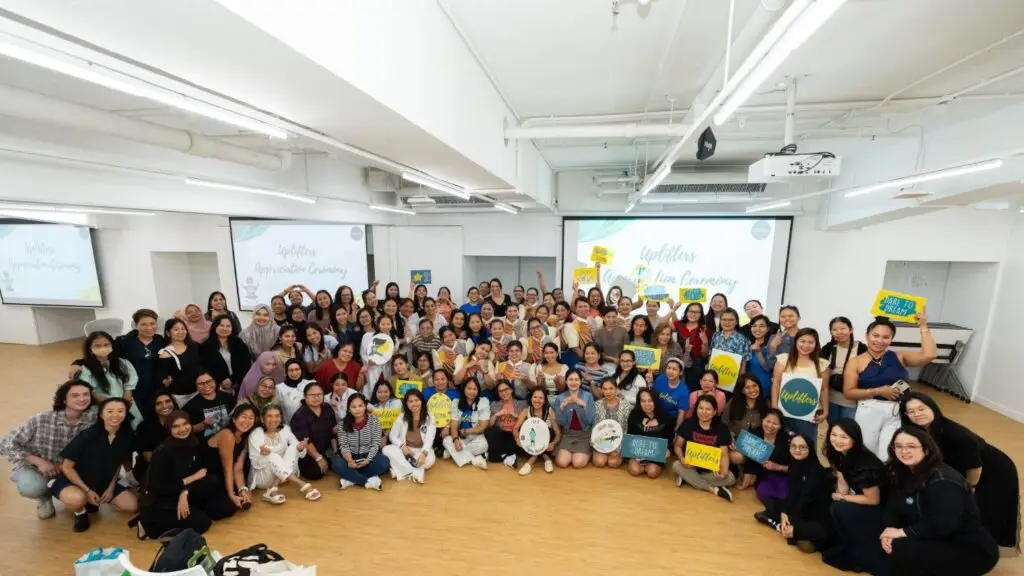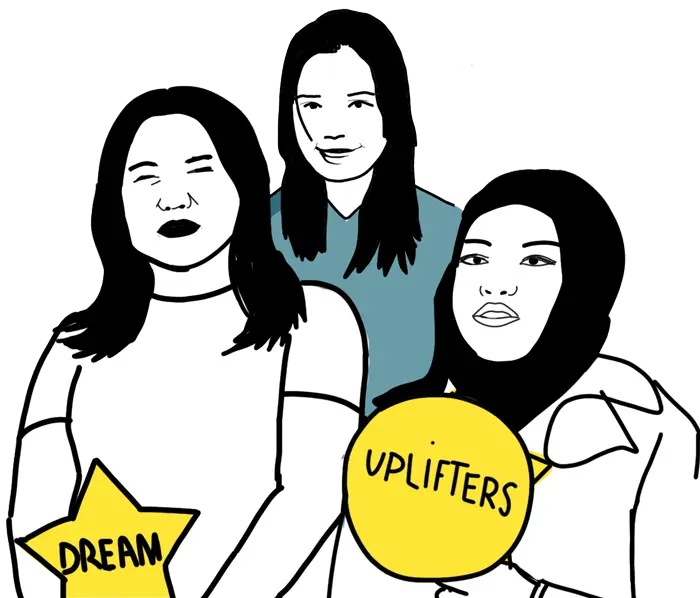Recently I’ve been approached by different organisations wondering how to transition their face-to-face programs to online courses and workshops in the face of COVID-19.
Here is a 5-step method that I’ve found useful to design impactful online courses. This method is especially helpful if you are targeting underprivileged communities and people who may not have very good internet access.
I’ve started my career as the director of an online education centre in France. Our 10,000+ students were preparing for national exams to become hairdressers or estheticians. My biggest pride was that we managed to improve the graduation ratio by implementing new e-learning tools and increasing the support they were receiving.
I like to say that if you can learn how to cut hair online, you can basically learn anything.
Two years ago, I founded Uplifters which is a non-profit organisation empowering underprivileged communities with online education and peer support. We offer a free three-week money management and personal growth online course to migrant domestic workers in Asia. Our challenge is to make online education truly accessible to women who own only a simple smartphone, have no WiFi, little digital literacy (no email address) and very limited time off. We started with twenty students a month in the first session and we are now enrolling more than 200 per month.
Here is what I have learnt along the way.
First, figure out how your audience accesses the Internet and their digital literacy.
- How is their Internet connection quality?
- What is the device they use? Mobile, tablet, laptop?
- Do they have storage on their devices?
- How flexible are their schedules?
- How long can they spend online in a quiet space without being interrupted?
- Do they have and use email addresses; alternatively social media platforms?
- Do they know how to download apps? Do they have enough storage for them on their phones?
(Just take a quick poll to make informed decisions)
2. Accordingly select the different tools you can use, taking into account bandwidth and schedule flexibility.
Make sure the tools you offer are:
- Accessible to your audience (for example videos require a good internet connection).
- Flexible enough to meet their needs (three-hour online meetings on Zoom are not for everyone). More information on low-bandwidth versus high bandwidth tools are in this article.
A special note on tools accessible through emails only. We tend to assume most people know how to use emails and access their mailbox easily however this is NOT the case.
3. Now, take the time to think about the best way to best deliver your knowledge depending on which tools are adapted to your audience.
Once you know what kind of tools you can use, think about how you will use them.
It is well known that lecture-style classes are not the best way to teach, even in real life. So imagine when someone is not even having the pressure of being looked at in a classroom.
As the idiom says “Tell me and I will forget; teach me and I may remember; involve me and I learn”. Neurosciences have recently shown that active learning is indeed more beneficial because it involves a greater number of neural connections, stimulating a variety of areas of the brain and promoting memory. Interacting with peers has been shown to be very efficient to stimulate learning. Teaching somebody what you are learning is actually a very effective way to deeply understand it and remember it.
Therefore avoid online lectures, by all means, otherwise, you risk losing your audience attention pretty quickly.
To help you do so, take the time to list your objectives, learning objectives and also your broader objectives like team building, building a sense of ownership, etc.
Let me share with you what we do at Uplifters to give you some ideas. We are targeting migrant domestic workers in South-East Asia. Our core signature program is a three-week course delivered through a Facebook chatbot on a daily basis. Students are supported in a group chat of ten people that is facilitated by a team leader, alumni trained to support her peers. The course is hosted on an online education platform but from a student’s perspective, you never leave Facebook messenger. This is necessary as most don’t use emails or internet browsers and have no storage on their phones to download additional apps. They share their “exercises” (we call them “challenges”) and participate in the discussions with their peers in their class chat when they can during the day. It’s totally asynchronous.
This program is designed to scale while guaranteeing impact but does not allow for a lot of interactions between students and experts (that would not be scalable nor realistic to ask them to connect regularly for scheduled video conferences with teachers).
We want to offer our most committed team leaders additional learning opportunities and more interactions with our office team. There are about thirty team leaders, located in either Hong Kong or Singapore so our initial plan was to organise three face-to-face workshops in each country throughout the year. We have built a pool of experts to share their knowledge during these seminars.
Of course, we had to think of an alternative because of COVID-19. For these workshops, we don’t have the same constraints. There are not that many members so we can afford to explain to them one by one how to use the tools and check beforehand what their availability is. One of our objectives is to keep building their sense of ownership towards Uplifters and have an interaction that goes beyond chat messages. So we will transition this one-day seminar to a one-week online seminar with material accessible asynchronously and scheduled short meetups together on video-conferences to discuss with the experts and have online team-building activities.
You will find good ideas on how to actually use Zoom in an interactive way in this article by Seth Godin.
To sum up: mix and match tools to recreate the kind of atmosphere you want in your regular classroom; make the most of asynchronous activities and keep live interactions short and as entertaining and engaging as possible.
4. The final question (not the first) is to compare available tools and platforms or develop a tailor-made one.
My two cents: this is no longer about technology. There are tons of affordable options. Don’t make the mistake to develop your own e-learning platform. Especially if you are a newbie, select one of the very best all-in-one stop platforms to host your content or even just a google website and zoom (or a similar tool) if you need to do videos. Your added value is not on the platform but in how you deliver your content (course design) and support your audience.
5. Test and learn
Let your audience know this is new to you and you are learning yourself as well. Accept the possibility of failure and be open-minded to change the way you do things. This is true in all times but even more when dealing with innovation. As we built Uplifters, we have realised that small incremental changes were working better than trying to build it “right” from the first day.
Moreover, don’t forget to assess yourself even if all seems to work. It seems these arrangements are exceptional but treat them as an opportunity to learn with the same feedback loop system you would have for your regular classes.
Bonus: how do you market or position it compared with your real-life workshops?
There are 3 kinds of online courses:
- Knowledge only (videos, text lessons, quizzes)
- Knowledge + interaction with peers
- Knowledge + coaching (with or without interaction with peers)
Your price (and completion ratio/impact) will depend on how you position yourself in between these three options.
What are the challenges you are facing while designing your online course? Please comment, I will try my best to reply!
A few words about Uplifters
Uplifters is a non-profit organisation registered in Hong Kong. Our mission is to empower vulnerable women in Hong Kong and Singapore with online education and peer support. We offer a free online course on money management and personal growth that is tailor-made for migrant domestic workers in South-East Asia.
There are more than three million migrant domestic workers in South East Asia and the Middle East. Despite spending years abroad trying to make money and being far away from their families and children, most domestic workers go back to their home countries to the same situation or worse off than when they left. They face tremendous financial pressure and are victims of unethical migration corridors leaving them caught in debt cycles.
Our mission at Uplifters is to empower them with the community support and the financial and personal development knowledge necessary to make their migration successful. Currently, 1,500 students (mostly Filipino and Indonesian) have enrolled in our courses since our launch two years ago and we expect 1,400 more by the end of 2020.
What’s unique about us is that Uplifters is a truly community-based organisation. Our students join class chats to discuss the lessons with their peers. These discussions are facilitated by alumni domestic workers who went through our “train the trainers” online program. Not only does it motivate them to complete the course, but it also guarantees that knowledge is transformed into action, hence making our programs both scalable and impactful. We have a 100% recommendation rate among our alumni. 97% said that it helped them reach their financial goals and 79% said our course transformed their lives. You can get a better sense of who they are and what we do by looking at our website, and Facebook page.
Because of the lack of funding due to the COVID-19 crisis, we are currently doing a crowdfunding campaign. Our objective is to raise USD $15,000 by May 10th. Many countries are giving subsidies if you feel as if you don’t depend on it, we would greatly appreciate it if you could consider donating it to us. More about it here.


